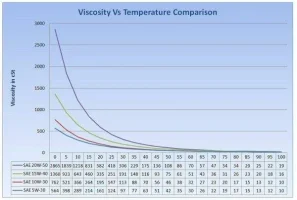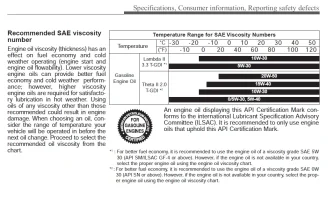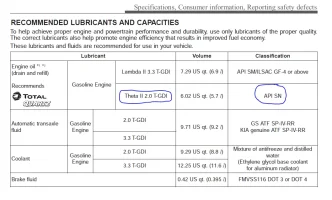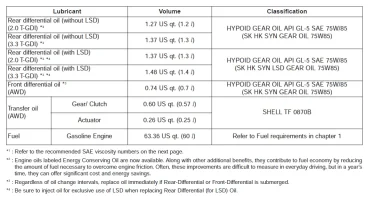Note: I have a lot of interesting links with GDI oil information to post, but due to the new user spam rules it is not possible to post them (totally understandable!).
I live in the Southern part of the USA where temps do not really get below 20F even during the worst part of the winter. Given the factory recommendations for oil viscosity, I have decided to use a 10W-30 oil in my Stinger’s 2.0L T-GDI Theta-II engine. Based on the sections outlined below, I’ve chosen Quaker State Ultimate Durability 10W-30 oil that is certified API SN Plus:
The 3.3L TTV6 engine is also direct injected, but it has additional port injectors that should help keep the intake valves much cleaner than the 2.0L engine (which only has direct injection). The information and choices I make may not be as applicable for that engine.
==== Goals:
Reduce intake valve deposits
Reduce the likelihood of low-speed pre-ignition
Be as cheap as possible
==== What we should be looking for in an oil:
Viscosity Index Improvers (VII, or viscosity modifiers): Low or NONE
==== Best practices:
Run Top-Tier Premium Gas (91 octane)
==== Good references:
Carbon Deposit formation:
API SN Plus / LSPI:
I live in the Southern part of the USA where temps do not really get below 20F even during the worst part of the winter. Given the factory recommendations for oil viscosity, I have decided to use a 10W-30 oil in my Stinger’s 2.0L T-GDI Theta-II engine. Based on the sections outlined below, I’ve chosen Quaker State Ultimate Durability 10W-30 oil that is certified API SN Plus:
- <reserved_for_future_link>
- <reserved_for_future_link>
- 5% NOACK and formulated for LSPI protection
- Amsoil Signature Series 5W-30
- <reserved_for_future_link>
- <reserved_for_future_link>
- 6.7% NOACK and formulated for LSPI protection
- <reserved_for_future_link>
- ~9% NOACK (not listed on data sheet) and formulated for LSPI protection
The 3.3L TTV6 engine is also direct injected, but it has additional port injectors that should help keep the intake valves much cleaner than the 2.0L engine (which only has direct injection). The information and choices I make may not be as applicable for that engine.
==== Goals:
Reduce intake valve deposits
- Intake valve deposits have been shown to be linked to the amount of viscosity modifiers in an oil. Wide span oils (such as 0W-30 or 5W-30) will have more viscosity modifiers than a narrow span oil (10W-30 or 5W-20). Oils of the same span will have different amounts of viscosity modifiers
- Oils with lower volatility (called NOACK) will have less oil vaporized into the PCV system. This may help with intake valve deposits, but should definitely help decrease the amount of oil that ends up in the intake (ie, inside the intercooler) and also help reduce oil consumption. The reason I say that low volatility *may* help with deposits is that many people believe that the oil introduced to the backside of the intake valve from being forced around the valve stem is the primary source of oil that forms the intake valve deposits. It has been shown that higher amounts of viscosity modifiers increase intake valve deposits, and the amount of modifiers used is linked to the NOACK results as I’ll discuss below. So there may be a direct and/or indirect link between oil volatility and intake valve deposits.
Reduce the likelihood of low-speed pre-ignition
- Low-Speed Pre-Ignition has been linked to high levels of Calcium and Sodium. New oils made for turbocharged direct injection engines have been formulated with additive packs that lower Calcium and increase Magnesium to compensate.
Be as cheap as possible
- This one should be obvious, right? You have to change the oil quite frequently in a turbo car, so let’s try to find something reasonably priced that ticks all the boxes!
==== What we should be looking for in an oil:
Viscosity Index Improvers (VII, or viscosity modifiers): Low or NONE
- For narrow span oils like SAE 5W-20, this can be accomplished by using synthetic base oils, also referred to as gas to liquids (GTL), poly-alpha olefins (PAOs) base oils or other base stocks with sufficiently high viscosity index. 10W-30 oils may also have very little VII.
- We don’t have a great way to know how much VII is used except by taking a look at NOACK volatility. Adding cheap VII’s to an oil rather than using more of the expensive base stock to get the wider span tends to increase NOACK.
- Low volatility means less oil sucked up by the PCV system because less oil aerosolizes when sprayed onto the bottom of the hot piston surface.
- Note that finding a cheap narrow-span oil (10W30) with a very low NOACK will be pretty easy, but finding a wider span oil (5W-30) will mean moving to much more expensive oils that use more of the expensive base stocks.
- Modern turbo GDI designed oils are moving to ~1000 ppm Calcium under the Dexos and API SN PLUS certifications.
- GM does not certify 10W-30 oils for Dexos (they’re more interested in fuel economy), so that won’t be much help if you’re looking for a 10W-30 oil.
- You’ll need to look at API SN PLUS or recent VOA (Virgin Oil Analysis).
- Prevents Low-Speed Pre-Ignition common on GDI engines
- Prevents Low-Speed Pre-Ignition common on GDI engines
- Calcium is somewhat okay, but is a real problem if combined with Sodium.
- Most good oils haven’t had much Sodium since forever.
- VOA and UOAs (Used Oil Analysis) will show the levels of this.
- Magnesium is used to offset a lower Calcium level, and doesn’t seem to affect LSPI. Many Dexos1 Gen2 oils are designed this way.
- It just depends on the oil manufacturer, but most are trending towards higher Magnesium and lower Calcium.
==== Best practices:
Run Top-Tier Premium Gas (91 octane)
- Higher octane will help prevent LSPI.
- Top-Tier gas additive packages will help keep your high-pressure injectors and the pistons clean (but probably won’t help much with the valves - that’s where the oil comes into play).
- Stick to a maximum of 5000-6000 miles as recommended by Kia.
- Turbo engines destroy oil much faster than a normally aspirated engine.
- Do as little idling as possible when the engine is cold - drive it slowly instead until the oil is warm.
- You will need to until wait a few minutes AFTER the coolant is up to temp before you start driving hard!
- Proper seating of the rings will reduce oil consumption, reduce blow-by, and reduce carbon deposits on the pistons and valves.
- Running the engine hard at break-in could also destroy it more quickly if it was built poorly (to poor tolerances), but you wouldn't want that engine in your car anyway, right?
- The factory engineers hopefully chose what they consider to be a proper break-in oil, so run it for at least 3000 miles before changing to a high-performance synthetic. Based on what I have read on other Kia forums from Kia dealer techs that have done warranty long block replacements (Kia delivering specific conventional oil with the engines), I would be surprised if Kia actually filled these engines with a synthetic oil at the factory. That's a good thing if so.
- Changing to a synthetic oil too soon could lead to poor ring seating, especially if you didn’t run the engine hard enough during break-in.
==== Good references:
Carbon Deposit formation:
- <reserved_for_future_link>
- <reserved_for_future_link>
- <reserved_for_future_link>
API SN Plus / LSPI:
- <reserved_for_future_link>
- <reserved_for_future_link>








